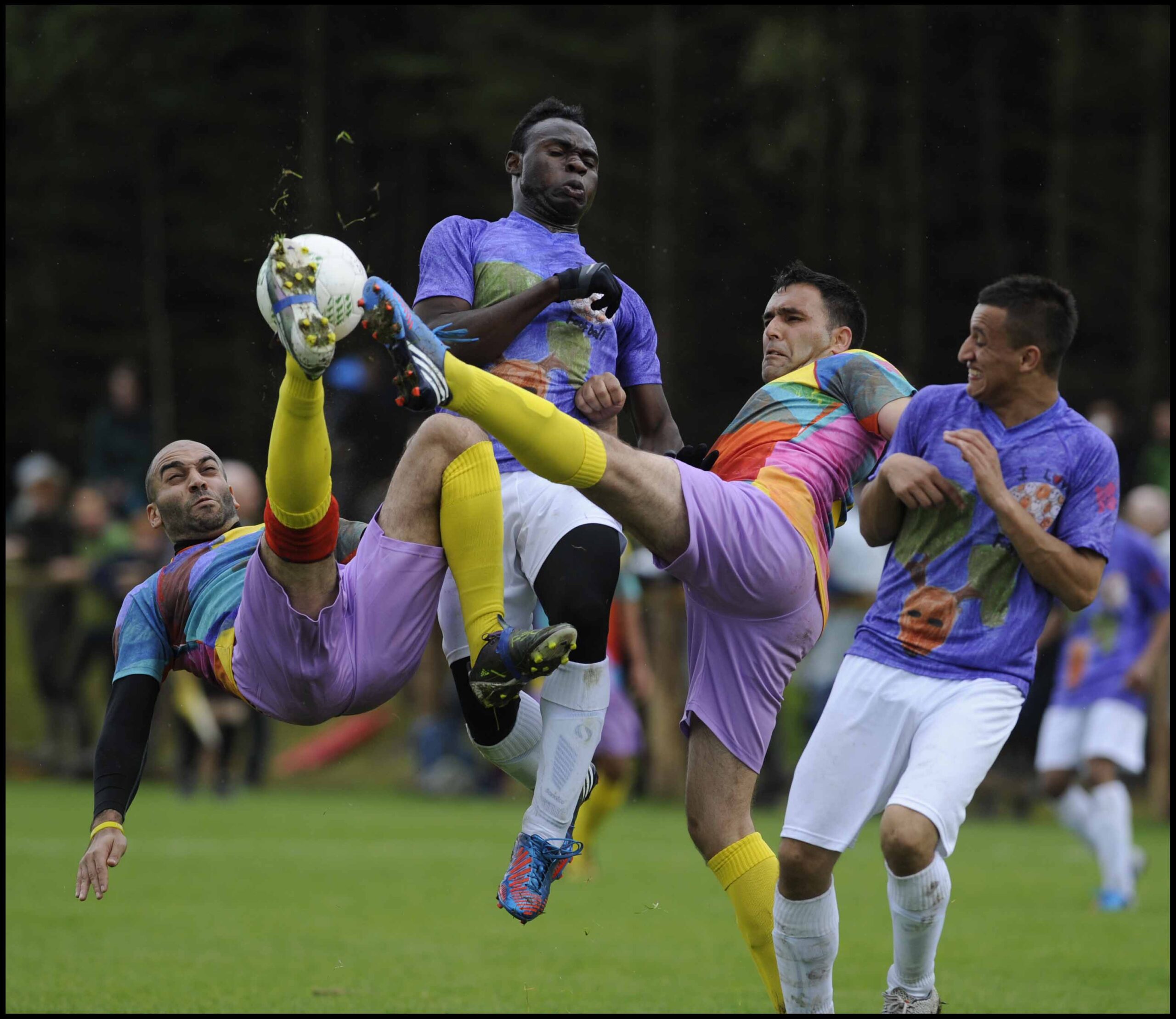
Photo: Matthew Shelly
Tabloid attack
From tabloid hostility to acts of God, Juliet Dean discusses the challenges of managing a major Cultural Olympiad arts project.
It was never going to be easy – a large-scale, experiential arts project involving football, immigrants, environmentalism and public money. As soon as it was announced that Edinburgh artist Craig Coulthard had been awarded a commission for his Forest Pitch project it came under tabloid attack. The Sun shrieked about “£460k on migrants-only footie”. These migrants included the same people the red tops have lauded in other circumstances – Iraqis who had helped British forces in Basra, Afghans who resisted the Taliban and Iranians escaping persecution.
Then there were the practical challenges, not least making financial ends meet in a three-year project linked with the Olympics, where tight rules hampered the prospects of raising extra cash through sponsorship. The project management role was also about helping a young and talented artist make the transition from small-scale works to delivering something large, complex and controversial.
Forest Pitch was an ‘Artists taking the lead’ commission, conceived as one of Scotland’s biggest contributions to the 2012 Cultural Olympiad. It was selected against tough competition because it so completely fulfilled the criteria of being a bold one-off artwork, involving an unexpected location, of celebrating the Olympic spirit, engaging with the young and providing legacy. Craig wanted to build a temporary football pitch in the heart of a forest and to create four extraordinary teams, largely made up of new Scots, to play there on one memorable afternoon.
At the very moment when Scotland faces a referendum on independence, the make-up of the teams would raise series issues about what it is to be Scottish or British. In a country where football can be entangled with sectarian divides, it was also about the way that amateur sport and Olympic ideals can be a powerful bonding force for people from varied backgrounds, classes, traditions and beliefs.
Phase two would see the arena become a living sculpture, with hundreds of saplings planted along the white lines and evolving into a ghost pitch. Open to the public, this would allow the events of 2012 to seep into mythology. Memory would be complemented by a film and book, providing more tangible records of the day.
Simply finding, and securing, a suitable piece of woodland involved a huge search. Fortunately Forest Pitch caught the imagination of the Duke of Buccleuch, and through him we found an ideal site on the Bowhill estate near Selkirk, leased to us for £1. Next came the twin tasks of managing a substantial landscape and design project while recruiting and coaching 60 male and female players from hard-to-reach groups.
All this was happening amidst media and popular curmudgeonliness about the Olympics before it had all been recast as a ‘sensational summer of sport’. What proved to be of fundamental importance (beyond the unwavering support of Creative Scotland) was that as we pushed out into all kinds of communities – ethnic and professional – we found huge amounts of goodwill. Architects, lawyers, contractors, refugee organisations, sports clubs, schools, journalists, bloggers, politicians and many others provided hugely generous assistance. Some of this was thanks to a robust media strategy which both emphasised the quality of the project and told the stories of the remarkable people taking part. Positive coverage eventually hugely outweighed the negative, as people got to hear about the players and how they had come to Scotland for many different reasons – for safety, love, work or study. As match day grew closer there was a real buzz among the players, in the press, on Twitter, Facebook and elsewhere.
In Scotland, however, there is always the weather. In the final weeks it rained ceaselessly and with just days to go the matches had to be postponed. The disappointment was huge. Picking things up and getting everyone re-energised and focused on a new date (while staying within the original budget) was daunting, but successful, with the games taking place towards the end of August.
We are now looking to the next phase: this autumn’s tree planting and a legacy that will still be there when today’s new Scots have become long-established families, like the Irish and Italians before them.
Juliet Dean is Director of PACE, a public arts agency.
http://www.paceprojects.org
Dealing with the tabloids
The arts can make popular targets for hostile tabloid coverage, though they can also receive superb and friendly coverage. Much can be done to reduce the chances of negative stories, or to mitigate the damage. If your project risks red top rancour here are a few suggestions.
Problem prevention:
• Anticipate complaints (perceived waste of public money is a favourite) and write yourself an FAQ-style reference list of responses in case they are raised.
• Help set the agenda by putting out strong and positive stories (the media, like nature, abhors a vacuum).
• If you have the backing of high-profile people or organisations admired by the tabloids ask them to provide quotes for a press release.
• Specialist PR support can be invaluable, but use people with relevant experience working with and in the national press.
If the dreaded call comes:
• Do not be bounced into instant comment – take note of the questions, agree a timetable to respond and stick to it.
• An email response can be best as there is a clear record of what you have said.
• If interviewed, be concise and friendly, do not fill gaps in the conversation and never drop your guard even if the journalist says it’s over – it won’t be.
• Saying ‘no comment’ makes you look bad, so always provide comment and, where possible, make it positive.
Matthew Shelley of Matthew Shelley Communications.
www.matthewshelley.net
Join the Discussion
You must be logged in to post a comment.